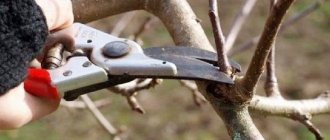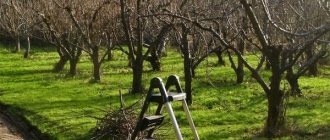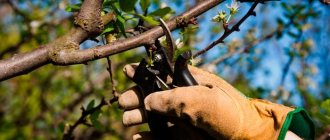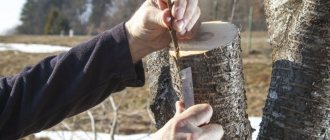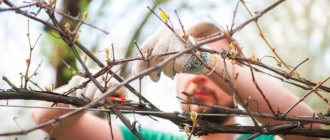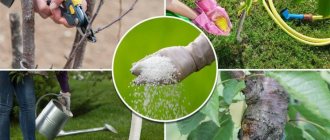- Seedlings and young trees
In this article we will talk about the basic rules for pruning apple trees in the spring and will try to cover all practical issues related to performing this important and responsible procedure. Pruning is one of the mandatory agrotechnical measures, as it contributes to obtaining annual harvests. Carried out correctly and in a timely manner, it allows you to collect up to 300 kg of apples from one tree (depending on the variety, age, soil and climatic conditions and weather factors).
Apple trees can safely be called the most common fruit trees in gardens and summer cottages.
Why do you prune apple trees in the spring?
Fruit trees need pruning of shoots and branches not only to create a lush crown of the correct shape, but also to stimulate plant growth, extend fruiting period, and improve the quality of ripe fruits.
The procedure and its rules will directly depend on the age of the tree.
The main reasons for pruning an apple tree in the spring:
- Trimming the crown of an apple tree is necessary in order to make harvesting the future harvest quick and trouble-free.
- The procedure helps strengthen the branches of the tree and direct their growth in the desired (correct) direction.
- Trimming helps stimulate the process of formation of new shoots, since during it you remove all deformed, dried and unnecessary branches.
- Pruning allows the plant to access light. Thinning the bush and removing shoots that thicken the crown helps normalize the supply of nutrition to the plant (regulate the process of photosynthesis).
- Proper pruning will help the plant survive the dormant period in winter more easily (provided that you prune the tree according to all the rules in the fall).
Booking in summer
Summer pruning tasks:
- Sanitation;
- Plant prevention;
- Pinching overgrowth;
- Breaking out unnecessary shoots;
- Removing vertically growing tops.
It should not be neglected, because... in summer, when the tree is covered with leaves and has a “full” appearance, it is more convenient to notice which shoots thicken the crown and create shade.
In addition, summer treatment helps protect the garden from pests .
The best time to prune apple trees
The procedure can be carried out at any time of the year, but most often gardeners prefer to choose spring or autumn for work. Trees are pruned much less frequently in the summer and they are almost never pruned in the winter.
The choice of the appropriate time will directly depend on the goal that the gardener pursues when carrying out the procedure:
- In the spring, they usually carry out sanitary pruning, i.e., they remove those shoots and branches that could not survive the winter cold and have dried out/deformed/broken/sick. You can start working with the plant only after it has begun to wake up, but before the buds open;
- in the fall, trees are pruned immediately after leaf fall ends, all dry and broken branches are removed, old shoots that will not survive the winter and will only take away nutrition from younger shoots;
- in summer the procedure is carried out quite rarely; usually at this time gardeners prefer to thin out the bushes if they are very thick, opening paths for sunlight to penetrate into the depths of the crown;
- In winter, pruning is carried out even less often than in summer, although apple trees tolerate it better than in summer: in winter, those who live in the southern regions of the country prefer to prune apple trees, because if you trim the branches in frost, the bark will be damaged, and the plant will freeze and die.
Recipes for preparing garden varnish
Var Zhukovsky
It is used exclusively in warm weather, as it is hard in cold weather.
Place in a bowl 1 part rosin, 1 part yellowish wax and 1 part melted warm beef fat. Stir gently until smooth.
Wait for the mixture to cool.
Pour cold water into a deep saucepan, pour in the mixture, wait a while for it to curdle. Take it out and mold it into a ball.
You can wrap the composition in several layers of oiled paper and store. When you apply the varnish to the wounds, cover it with a cloth so as not to attract pollinating insects.
Var Pashkevich
Made from 1 part wax, 1 part turpentine, ½ part rosin and ¼ part fat.
Choose metal utensils that can be placed on the fire.
Place the wax in it and melt it until it becomes liquid. Do not remove the cookware from the heat. Add to it the same part of turpentine and half of the purified rosin. When the composition is homogeneous, add ¼ of the fat.
Also fill a container with cold water and place the brew in it. Watch a useful video on how to make rosin:
Var is stored in oiled paper.
To use, spread a thin layer of varnish on a cotton cloth and wrap the cloth over the wound.
Advice! Varis that can be used in winter: Gaug, Reshetnikov, Raevsky.
Var Gauta
Place 400 g of pine resin in a metal bowl, heat it, pour in 60 ml of pure medical alcohol. Pour 1 teaspoon of baking soda and 4 g of gum into water, then pour the composition into a bowl with resin and alcohol, mix everything, cool.
Apply with a brush to cracks and cuts.
Reshetnikov ointment
Place 10 parts of fir resin and 1 part of yellow wax in a metal bowl, place on low heat, leave until melted, stirring continuously.
After cooling the ointment, but so that it remains warm, pour in 1 part of wine alcohol.
Use a brush to lubricate the wounds.
The ointment can be used even in frosty conditions. It does not allow water to pass through, and no cracks appear on it.
Var Raevsky
Melt half a kilogram of tree resin, stir constantly, pour in 60 ml of medical alcohol and 2 tbsp. spoons of flax oil.
Mix and store in a tin jar.
What you need to prepare before starting work
Every self-respecting gardener should have at least the minimum tools necessary for gardening work. To trim apple trees you will need:
- pruner;
- hacksaw;
- a tool for removing knots (usually a lopper);
- garden shears or knife.
Handle sharp tools very carefully so as, firstly, not to harm yourself, and, secondly, not to damage the plant.
Before pruning, you should be sure to disinfect all the tools you have so that through the cut you do not introduce infection or pests into the tissue of the apple tree.
If you use a saw, sharpen it well, since a dull file will not cut the bark, but tear it, which causes serious and irreparable damage to the plant crop.
Preparation
To carry out high-quality pruning, in addition to knowledge or guidance, you need high-quality tools and means for processing cuts.
Tools
To prune fruit trees, you will need a sharp, clean and disinfected tool without traces of corrosion - rust can cause rotting of the branches, and then the entire tree.
Inexperienced gardeners are sure that any construction saw is suitable for pruning. In fact, the job requires a whole arsenal of tools. When pruning in spring you will have to use:
- pruning shears;
- garden knife;
- loppers with rods of different lengths - to remove hard-to-reach branches;
- garden saws with special bends and a narrowing at the end of the blade.
The cuts must be perfectly straight. If you are inexperienced, do some practice pruning before approaching the fruit tree.
Take a bottle of alcohol with you to the garden - clean your tools before work and after each cut branch.
Processing means
To prevent sap from leaking out and infecting the tree, be sure to lubricate the branches with one of the treatments. Can be used:
- garden mastic or garden varnish;
- a solution of copper sulfate and lime in a ratio of 1:10;
- plasticine;
- oil paint.
There is an opinion that trees do not need processing of cuts, they supposedly will recover better this way. Whether to lubricate the cuts or not is up to each gardener to decide for himself.
Instructions: proper pruning of apple trees in spring for beginner gardeners
Anyone new to gardening, having planted an apple tree on their plot, must clearly know how to care for this plant and when to trim the tree. The most important pruning is carried out in the spring and includes shortening and thinning the crown.
The following are removed from the crown:
- shoots that grow inside the crown;
- branches that do not allow young shoots and main shoots to form;
- weak and non-fruit-forming plant parts;
- deformed, damaged, dried and diseased plant elements.
In order to facilitate and speed up the collection of fruits, the lateral layers and central shoots are shortened.
General cutting rules for all types of apple trees:
- Plantings are cared for year-round, and not just before and after pruning.
- Vertically growing shoots are pruned.
- Sanitary pruning should be carried out at least once a year.
- In summer, thickening, if any, is usually removed. The quantity, size and taste of the fruit depends on this.
- Large branches should be cut at an angle of 45°.
- Thin shoots are cut under the bud.
The timing of spring pruning will depend on the region where apple crops are grown. Remember that pruning should not be done while there is still snow in the garden (too early), or after the plant has begun to bud (too late).
Carry out all work in warm weather before the juices begin to move in the tissues of the tree.
How to prune young plants in spring
After planting the seedling, you need to prune it to form the correct plant crown.
Scheme of work:
- For a young tree at the age of 2 years, you need to trim the main trunk so that it rises 4-5 buds above the branches.
- All long shoots that grow at an acute angle must be cut off, as they will simply break under the weight of the apples.
- Layers that grow at right angles can be left, but at the same time shorten them by 3–5 buds.
Trimming mature trees
For mature trees, spring pruning is a real salvation - it prolongs the life of the plant, normalizes fruiting, and makes the fruits more juicy and tasty.
Basic rules for pruning adult and old apple trees:
- First you need to carefully examine the plant. During the examination, all diseased or damaged branches are identified. If there are too many diseased shoots, then pruning is unlikely to help revive the tree.
- Spring pruning can be done only after all the snow has melted, but before the buds open.
- Before starting work, you must immediately prepare and disinfect all tools.
Haircut pattern:
- To give the tree the correct shape and somewhat rejuvenate it, remove all deformed, diseased and growing shoots in the wrong direction. Also remove any branches that are too large or unpromising.
- First, cut off the lower shoots, which will definitely no longer bear fruit. Cut into a ring.
- After this, remove all dry shoots and layering with traces of disease. Crossing branches must also be removed. You can cut them off entirely, or you can shorten them a little (by a third). This is necessary in order to avoid thickening of the crown, competition between shoots and possible damage to branches against each other.
- Carefully thin out the tree's canopy and shorten its side branches so that it can receive enough light.
How to prune columnar apple trees
Columnar varieties have many advantages over classic apple trees:
- earlier fruiting;
- small height (convenient to pick fruits);
- ease of care.
For these varieties, pruning is one of the basic care rules. If you exclude it, the crown of the tree will thicken, the amount of harvest will be reduced, and the plant itself will begin to hurt.
Haircut pattern:
- In the first year after planting, you need to shorten the trunk and remove the lateral shoots.
- In the second year of cultivation, side shoots are pinched to a length of 30–40 cm.
- In the third year of growth, you need to provide the plant with pinching of the upper shoot at a length of 25 cm (side branches - up to 40 cm).
- In the fourth year, you need to thin out the crown somewhat, removing shoots that grow inward.
- In the fifth year, you need to limit the growth of the tree. The optimal height of the bush is considered to be 3 m. In summer, you need to remove all weak shoots that thicken the crown.
- In subsequent years of cultivation, only standard sanitary pruning should be carried out.
Advantages and disadvantages
Spring pruning is a mandatory event with many advantages:
- Forms a beautiful crown.
- Strengthens the trunk and branches.
- Increases light penetration to fruits.
- Frees from damaged branches.
- Prevents the development of diseases.
- Reduces the number of apple pest larvae.
- Allows you to get the desired number of fruiting branches.
- Rejuvenates old branches and increases the strength of young branches.
There is only one drawback to spring pruning - the difficulty of determining the optimal timing. Gardeners have to rely on the weather and their intuition.
Proper spring pruning will allow you to grow a beautiful, strong and productive tree from a small seedling. Remember that pruning is especially important in the first years of life, so prepare carefully for the event, study the instructions, sharpen the tool and grab a garden varnish.
0
0
Copy link
Tips for beginners on autumn pruning of apple trees
Autumn pruning is one of the points in preparing the apple tree for a full winter. The gardener himself decides which cutting scheme and technology to choose.
Here are two main ways to trim an apple tree in the fall:
- thinning (complete removal of shoots);
- shortening (removing a third of the branches).
Any shortening of the branches will lead to rapid growth and more abundant branching of young shoots. In place of severe pruning, about 3-4 strong young shoots will soon appear. A weak haircut will lead to the formation of shorter branches.
Do not forget about thinning - this procedure helps to get a rich harvest in the new season, since the branches, leaves and fruits will receive enough sunlight.
Crown formation options
Crown formation is one of the most important nuances of autumn pruning of apple trees. The level of productivity, as well as the speed of plant growth, will depend on it.
Tiered-sparse
The simplest option for forming the correct crown, the shoots will be arranged in a tier. If you choose this pruning method, please note that all tree crowns should be located at a distance of 3 meters or more from each other.
Formation:
- Shorten the main trunk. In the first year after planting, its height should not exceed 50 cm.
- After 6 months, start cutting the shoots as if in a mirror image. In the first tier the distance should be approximately 30–35 cm, and in the second and the rest – 15–20 cm.
- Next season you need to form another tier (45 cm from the previous one).
- Maintain the shape of the crown in the future by cutting off the base shoots above the single shoot at the top.
spindle shape
A fairly quick way to form the skeleton of a conductive shoot. Such pruning should only be carried out by gardeners who already have experience working with apple trees and other fruit trees.
Bowl shape
You should not choose this form for those apple trees that grow too poorly. Due to slow growth, the apple tree will not be able to form a crown of the desired shape.
fan palmette
This method of formative pruning is suitable for those apple trees that are grown around the entire perimeter of the summer cottage. Formation will take approximately 3-4 years, so only choose it if you are willing to wait.
Autumn pruning scheme
Most often, two types of pruning are carried out in the fall - formative and sanitary. If you do not need shaping, it is necessary to carry out sanitary thinning of the tree in the autumn.
During this pruning, all dried, deformed, weak shoots are removed, as well as branches that cross each other or grow at an acute angle. Work should begin when the leaves have completely fallen from the trees, but the first frost has not yet arrived.
Here are several ways to trim apple trees in the fall:
- weak (suitable for young seedlings, a quarter of the length of the annual growth of shoots is cut off);
- medium (suitable for mature trees 5–7 years old, a third of the shoots are cut off);
- strong (option for old plantings, large branches are removed by about half).
Subtleties of the procedure
Despite the fact that pruning cannot be called a complex operation, proper preparation is required to carry it out. First of all, you need to inspect the crown and select the branches to be removed. These include shoots that cover the central conductor during their growth or interfere with the development of skeletal branches. It is also necessary to get rid of weak, broken branches damaged by pests or frost.
Ring trimming
When using this technology, the branch is completely removed (usually diseased shoots are eliminated in this way). At its base there is a small thickening called the “ring”.
The cut is made at an angle directly under this influx. Large branches are first shortened, and then the stump is trimmed along the upper edge of the ring.
There should be no nicks left on the saw cut, otherwise the wound will take a long time to heal. The resulting cut after the procedure is treated with special compounds.
When pruning trees into a ring, the wound heals much faster due to the accumulation of rapidly dividing cells in this place.
Pruning "to the bud"
This method is used to stimulate branching and provides two ways to shorten the shoot:
To the outer bud. It is usually used to thin out an overly dense crown. The cut is made above the bud, “looking” in the direction of the outer side of the crown.- On the inner kidney. This method is used with a spreading crown in order to strengthen the center. In this case, the bud faces the center of the crown.
The cut should be made at an angle just above the bud (approximately 0.5 cm). Leaving a long stump will slow down the healing of the wound, and a cut located close to the kidney can damage it.
In some cases, brown wood can be observed inside the cut, then the branch is cut back to healthy tissue.
The nuances of pruning apple trees in winter
In winter, you can trim only those apple trees that are grown in the southern regions of the country (where the air temperature does not drop below -10 degrees). This procedure has several important advantages:
- The plant is in a dormant state, so it experiences minimal stress.
- The risk of damage to the cortex is reduced.
- Reduces the risk of infection or pests.
Only frost-resistant varieties can be pruned in winter. During it, the branches are completely cut off.
Deadlines
The time suitable for spring pruning is when two conditions are met:
- The movement of juices has not yet begun (marked by the appearance of buds). Pruning during this period is good for two reasons: in a state of hibernation, the tree better tolerates the stress of removing branches and shoots and reduces the consumption of vital juices;
- The snow has already melted and the temperature outside is above zero. Fresh wounds caught by frost often rot. It is generally prohibited to prune in frosty conditions: in such conditions the wood is fragile and chips, causing the tree to suffer greatly.
In central Russia, March usually meets these criteria. At higher latitudes - April.
Pinching (pinching)
Performed in summer and spring, pinching (pinching) an apple tree - removing the grassy tip of a shoot - is done with your fingers or pruning shears.
More on Tele4n.Net:
What to feed apple trees in the summer by month: June, July, August. Experience of professionals
It redirects tree sap to root growth, does not allow excess branches to grow , but strengthens skeletal ones and forms fruits, promoting earlier fruiting.
Shoots of poorly branching varieties are pinched when three visible buds appear on them. Strongly branching shoots - above five buds.
In the month of May, sprouts that have reached a length of 12-15 cm are pinched above the fourth or fifth leaf.
Pinching of apple trees is carried out until mid-July so as not to reduce the frost resistance of the branch.
Banding
The purpose of ringing is to stop the flow of photosynthetic products from the leaves to the roots. This ensures better formation of flower buds and promotes fruiting.
With this procedure, a strip of bark is cut off , and the exposed part is smeared with garden varnish and bandaged with electrical tape (polyethylene). You can also make cuts in the shape of a half ring; the bark must be removed carefully.
IMPORTANT! The first cut should be strictly parallel to the second, and the distance between them should be 1 cm.
The method is suitable for viable fattening trees , especially apple trees. Banding is not carried out on skeletal branches, as it can weaken the crown.
Below you can see the ringing of an apple tree (video):
